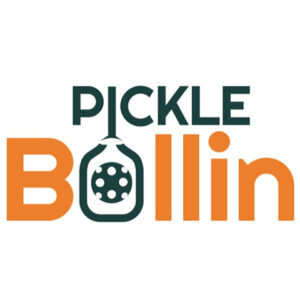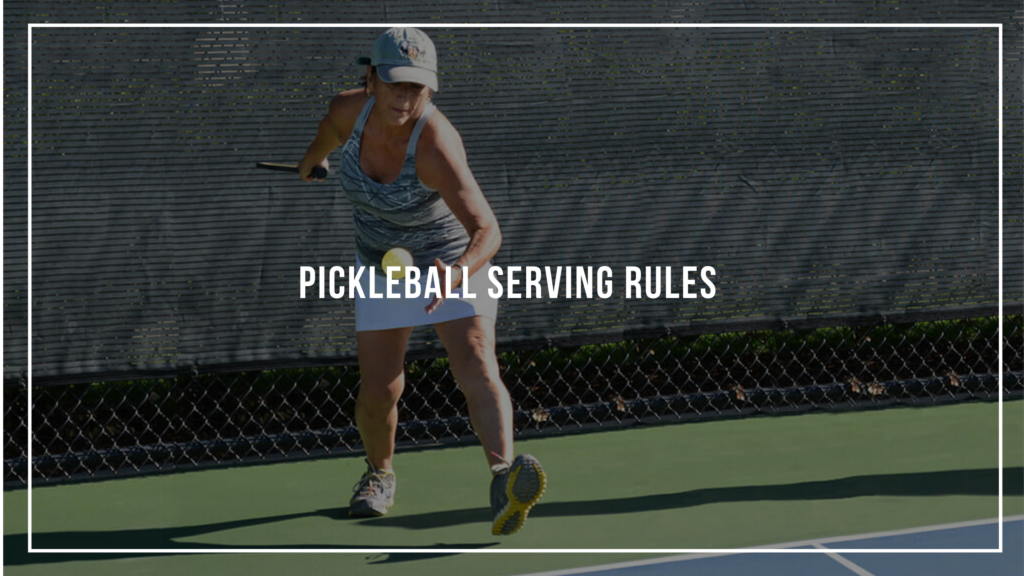
Pickleball first debuted in 1965 in Bainbridge Island, Washington, but it still has quite the following today. Pickleball serving rules are often a topic of discussion during gameplay. Players find it so addictive that there’s now an entire industry built around the sport, including an International Federation of Pickleball (IFP).
Since its inception, the International Federation of Pickleball has held over twelve tournaments. They’ve gained over 127 world ambassadors, and 34 countries are members. The IFP oversees the Official Rulebook for Pickleball. Their goal is to introduce the sport to all nations so that it can ultimately become an Olympic sport.
If you’re looking for a complete beginner’s guide to pickleball check out: Pickleball Strategy: Complete Beginners Guide !
!
What is Pickleball?
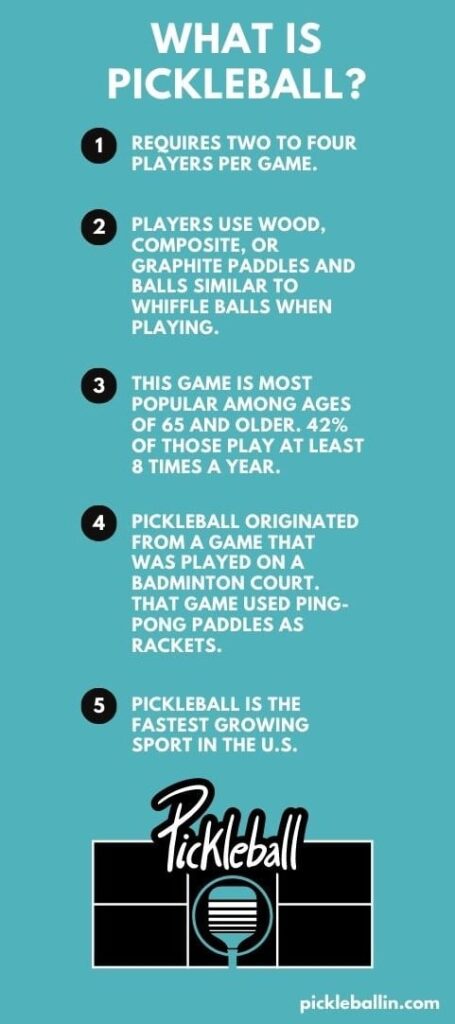
Pickleball is a sport where two or four players use paddles to hit a ball back and forth. The sport combines elements from:
- Ping-pong
- Tennis
- Badminton
Pickleball uses a badminton court, which is smaller than a tennis court. A net that resembles a modified tennis net. The smaller court size means that you can play Pickleball indoors or outdoors. The paddle is larger than a ping pong paddle but solid.
A pickleball is a smaller plastic ball with holes, but many players use tennis balls as they’re easier to find. There are pickleball serving rules to observe, and when you’re learning how to serve in Pickleball, serving rules often get discussed.
Pickleball is considered a less intense sport to play than tennis since it utilizes an underhand technique that is easier on the shoulder. Pickleball also uses a smaller court that measures 20 feet wide and 44 feet long for both single and double games.
This smaller size means less aggressive back and forth movement. This makes it an excellent fit for mature adults, those who are differently-abled, and individuals looking for a more simple form of exercise that’s fun for the whole family.
Serving the Ball
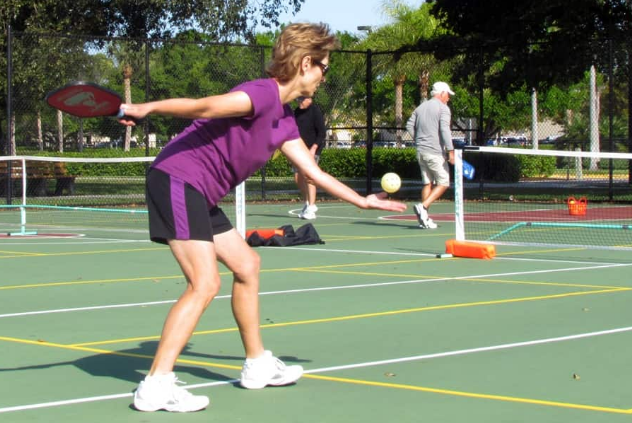
If you want to play the game successfully, you’ll need to understand the rules for serving in Pickleball. As well as the technique used for legal serves. The team that serves the ball and the ball’s route determines the points earned and other critical events in the game.
Purpose
Unlike with other sports, the purpose of serving the ball in Pickleball is to get the ball in play. You do not want to hit the ball aggressively or as hard as possible. A common mistake with new players is that they think they must quickly and powerfully serve the ball to overtake their opponent. This is one potential strategy, but not one that comes highly recommended.
Technique
Proper serves travel diagonally across the court, starting with the “right-hand serving square” and alternating for each serve. Each serve has to clear the “non-volley zone,” which is the seven-foot portion of the court directly on either side of the net.
Once the ball has cleared the net, it must land in the service court diagonal from its starting point. If it doesn’t it’s not valid. Players must also serve the ball with an underhand motion with the paddle, and the paddle must remain below the waist for the whole serve.
Pickleball serving line rules also require that players keep both of their feet behind the court’s line when serving. The ball cannot bounce before touching the paddle. This motion may sound easy, but it does take some practice to get right. Aiming the ball towards the correct portion of the court on the opposite side of the net can take some skill.
Tips for Legally Serving the Ball in Pickleball
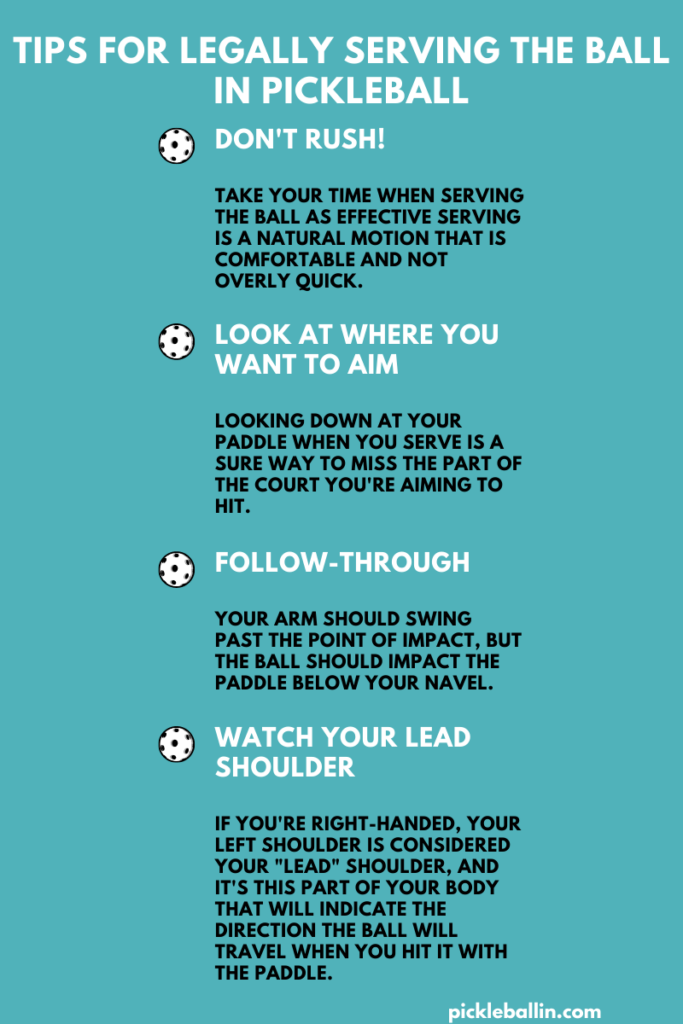
There are a few tips to keep in mind for the best serves when it comes to Pickleball serving rules. Here are some helpful tips for getting the serve right and maintaining your advantage during the game:
- Don’t Rush! Take your time when serving the ball as effective serving is a natural motion that is comfortable and not overly quick. The motion should feel similar to bowling, and your movements should be smooth.
- Look at where you want to aim: Looking down at your paddle when you serve is a sure way to miss the part of the court you’re aiming to hit. Instead, lock your eyes on your target. Keep that place in mind as you look at your paddle briefly to serve. This strategy is similar to golf in the sense that you orient where you will hit the ball before actually hitting it.
- Follow-through: Your arm should swing past the point of impact, but the ball should impact the paddle below your navel. After impact, the paddle in your hand should swing up to approximately shoulder height in a smooth motion.
- Watch your lead shoulder: If you’re right-handed, your left shoulder is considered your “lead” shoulder. It’s this part of your body that will indicate the direction the ball will travel when you hit it with the paddle. For better aim, orient the correct shoulder in the same direction as your target before serving.
If you find yourself in need of more specific tips and tricks for serving and greater detail about what are the rules for serving in Pickleball, there are a number of videos online that focus specifically on this topic. These videos also provide an excellent demonstration of technique and help provide a visual of the court at the same time.
Serving Strategies
It may surprise you to learn that the team serving the ball in a Pickleball game is at a disadvantage. Which is different than in other sports such as tennis. This disadvantage comes from the receiving team having the opportunity to move towards the net. This makes it easier for them to prevent the other side from scoring.
There are also a few strategy differences to consider when you are playing a doubles game of Pickleball. Aiming consistency will always be your friend when it comes to serving. Here are a few other strategies to consider at different points of the game whether you’re playing with two players or four:
- Aggressively serving the ball won’t necessarily guarantee that you’ll win a point, and it might actually backfire. The best idea is to serve carefully and precisely aim towards the appropriate side of the court. You want to get the ball in play and give your team the best possible chance of scoring.
- Once you get better at aiming the ball, you can focus on the finer points of serving. Some finer points are the spin, velocity, and exact placement of the ball. Until you’ve mastered a consistent serve, don’t worry about mixing up different types of serves.
- To throw your opponents off, you can serve to their backhand where they are weaker. Mix up how deeply you serve the ball on the court, and choose different locations for where you serve the ball. Many players dislike higher balls, so this can be another strategy to use when serving, and many players will consistently choose a firm and deep serve.
- When you play a doubles round of Pickleball, you’ll find that the play doesn’t get interesting until the third shot occurs. This progression is partly because there are two players on either side, but there is also less room for error and, therefore, an increased emphasis on your serving and how consistently you can hit the ball where it needs to go.
As you get better at serving and consistently aiming the ball precisely to other parts of the court, you can attempt different non-standard serves such as sharp angle serves and heavy-spin serves. These aren’t beginner moves, and there’s a lower probability of success even if you’re proficient at them, but they offer a compelling mix of serves that you can use against your opponent.
More About Pickleball Rules
If you’re new to Pickleball, it may seem like there are a lot of rules to learn outside of the Pickleball serving rules, but once you get the general idea of the gameplay, it becomes much more comfortable. Here are some of the standard practices of play you’ll need to be familiar with outside of serving and common situations you might encounter.
Double Bounce Rule
When the ball is served and crosses the net, the receiving side must allow the ball to bounce once before hitting it again to return it. Upon return, the ball must bounce once before the serving team hits it back. Once each side has hit the ball after it has bounced once, the ball can then get hit without bouncing, provided you aren’t within the non-volley zone.
While this rule can be tricky to keep track of, it’s a formality of gameplay that extends the rally and eliminates any unfair advantage. This rule also gets called the Two-Bounce rule. Players in wheelchairs are often allowed to have the ball bounce twice on each side of the court as they work to position themselves.
Faults
Faults can be a wide variety of actions that cause gameplay to stop due to a violation of the rules. When the receiving team faults, the serving team gets the point; however, the opposition gets the opportunity to serve when the serving team faults.
You’ll need to read the Pickleball rulebook for a complete list of the rules that result or impact faults, but here are a few common faults that occur during gameplay:
- Serving violations
- A ball impacts the paddle before bouncing on both sides after serving
- A served ball doesn’t land within the boundaries of the court on the receiving side
- A ball strikes a player, what they’re wearing, or what they’re carrying
- The ball strikes an object before it bounces on the court
- A ball is hit into the net or travels outside of the court or out of bounds
- A ball gets volleyed while in the non-volley portion of the court
- The ball bounces more than once before hit by the receiving player
It’s worth mentioning that the lines that outline the non-volley zone matter when it comes to a fault as they get included as part of the non-volley zone. If a ball touches this dividing line when served, it still counts as a fault.
Volleys
Volleys are simple movements where a player hits the ball in play without first allowing it to bounce. This action is only allowed when players are outside the non-volley zone that spans the seven feet on either side of the net, and if the player oversteps this boundary, it’s called a volley follow-through.
If the ball hits the player when they are standing in the non-volley zone, a point is lost. Likewise, points are lost if a player steps into the non-volley zone while hitting the ball. Even if the ball gets labeled “dead” before this happens.
If part of your foot is over the adjacent line for this zone, you’re inside of it. However, you are allowed to reach over the line to hit a ball, provided your feet don’t cross into the zone in the process.
If you serve the ball into the non-volley zone, your team loses a point. Your paddle is also not allowed to touch the non-volley zone before or after touching the ball, and this is considered a fault.
You are welcome to stay inside of the non-volley zone as long as you like during gameplay. There’s no penalty during a doubles match if your partner is in the non-volley zone. When you return a ball from outside of this zone.
Keeping Score
The referee will call out the score after the players are in position and ready to play. This declaration starts the ten-second rule where the server has ten seconds to serve the ball. Only the serving team can score points. Games usually conclude at eleven points, with one team winning by at least two points.
For tournament games, the total points required to win might extend to fifteen or twenty-one with a margin of two points to win.
The score also dictates where players stand. The serving team’s first server stands at the right side of the court when the score is even for their team. That player moves to the other side when their score is uneven. The opposing team follows the same rules when serving based on their score.
Double Play Positioning and Movements
There are a few modifications to Pickleball when you are playing a game of doubles. The most notable is that there are two players on each side, spaced equally apart. One person is the primary server and the other as “server 2.”
Gameplay starts on the right side of the court for serving, with the main server or starting server. They will alternate sides after each point is given to their team, so both players get to serve equally.
The receiving team does not alternate their positions after the opposing team scores. They may switch after the return of the serve, providing the rally is still in progress. Once the rally ends, they must return to their original positions.
Before serving the ball, the receiving team always has the option to ask the referee for the score. This allows them to confirm the correct positioning of their players.
What Equipment You Need to Play
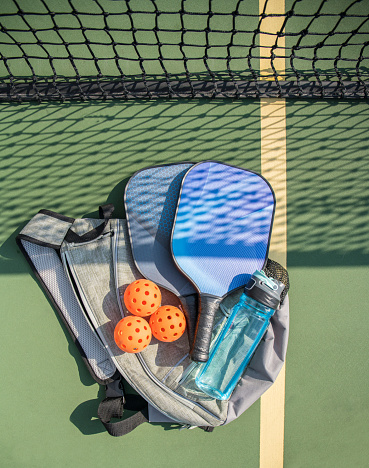
To play Pickleball, you’ll need to have a court  or temporary space to play. You can use an existing tennis court or set up a temporary court based on official guidelines. You’ll also need special Pickleball paddles and Pickleball balls. But some players choose to use tennis balls for casual play with friends.
or temporary space to play. You can use an existing tennis court or set up a temporary court based on official guidelines. You’ll also need special Pickleball paddles and Pickleball balls. But some players choose to use tennis balls for casual play with friends.
Everyday sneakers work well for Pickleball. You won’t need specialized footwear to play on a standard court, whether it’s indoors or outdoors. Some players also choose to use gloves, but this isn’t necessary. Special Pickleball nets are also available, and these can be helpful if you are setting up your own court.
New Rules for 2021
For 2021, the USA Pickleball team has published a simplified rulebook to help make gameplay more accessible for casual players.
This Alternate Rulebook is not a replacement for the official rulebook, tournaments still use it today. However, it does reimagine the information you need to play the game in a way that is easier for new players to understand and seasoned players to reference quickly.
You can download the Alternate Rulebook for free online. There is a one-year period where anyone can contribute their comments to the USA Pickleball organization directly.
Conclusion
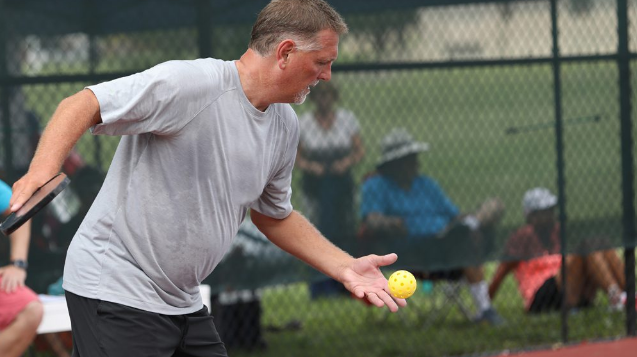
Pickleball is a unique sport that is more accessible to a broader audience than other forms of exercise. This sport combines elements from badminton, tennis, and ping-pong in an easy to understand manner. This makes it suitable for those in a wheelchair, mature adults, and families with members of all ages.
Pickleball serving rules are relatively straightforward once you get the skill of serving down, and sticking to the rules. They help you eliminate any unfair advantages and extends playing time. This maximizes the fun without sacrificing the exciting challenge the game presents.
You also don’t need a ton of special equipment to start playing Pickleball. Learning to serve is a quick process so you can start having fun immediately.
Looking for more? Here are some of our other guides we recommend:
Learn: About Pickleball , Why is it Called Pickleball?
, Why is it Called Pickleball? , Pickleball Rules
, Pickleball Rules , Pickleball Court Dimensions
, Pickleball Court Dimensions , What is Pickleball?
, What is Pickleball? , What is a Fault in Pickleball?, and Pickleball Singles vs Doubles – Strategies and Rules
, What is a Fault in Pickleball?, and Pickleball Singles vs Doubles – Strategies and Rules .
.
Equipment: Best Pickleball Clothes for Men and Women , Best Pickleball Accessories And Must-Have Gear
, Best Pickleball Accessories And Must-Have Gear , Best Pickleball Paddle in 2021, and Men’s Pickleball Shorts.
, Best Pickleball Paddle in 2021, and Men’s Pickleball Shorts.
